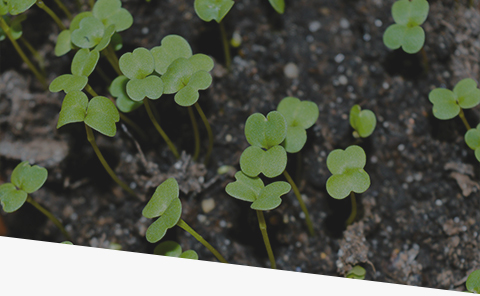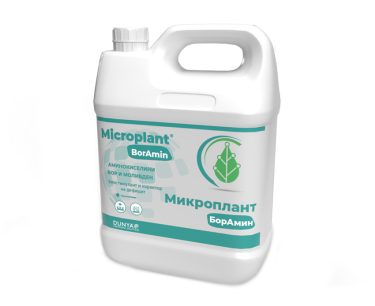- Rapid absorption and translocation of boron within the plant
- Recovery of crops under biotic and abiotic stress conditions (cold, drought, hail)
- Enhances the processes of flowering, pollination, and fruit setting; reduces the number of nonviable flowers and grains
- Stimulates photosynthesis and fruit formation
- Improves cell division, reproduction, and growth—facilitates the rapid recovery of damaged tissues and organs; activates the growth of meristematic tissues (roots and shoots)
- Enhances the translocation of calcium between tissues
- Ensures even nutrient distribution and optimal growth and firmness of the fruits
- Reduces leaf shedding and fruit dropping
- Improves fruit quality by limiting physiopathologies and deformities
Microplant BorAmin
Highly concentrated liquid fertilizer with watersoluble boron as boron ethanolamine, enriched with free L-amino acids, which are easily assimilated by plants in foliar nutrition. Its application has a double effect, on the one hand correcting and preventing boron and molybdenum deficiency, while also inducing a biostimulating effect on the plant, thereby activating a large number of metabolic processes.
Aspartic acid 7,27% – Glutamic acid 11,00% – Alanine 4,82% – Arginine 7,15% – Cysteine 2,51% Phenyl Alanine 5,17% – Glycine 7,95% – Histidine 0,75% – Isoleucine 4,95% – Leucine 8,08% – Lysine 1,87% – Methionine 0,47% – Proline 10,95% – Serine 12,82% – Tyrosine 1,09% – Threonine 4,88% – Valine 8,31% (PERCENTAGE OF THE TOTAL AMOUNT OF FREE AMINO ACIDS)
The recommended dose rates are indicative. For more precise application, kindly seek advice from our agronomists or submit an inquiry HERE
When mixing with mineral oils, copper, sulfur, calcium sulfate and alkaline products make a preliminary compatibility test. Do not apply to plum trees as there is a risk of phytotoxicity.
- Rapid absorption and translocation of boron within the plant
- Recovery of crops under biotic and abiotic stress conditions (cold, drought, hail)
- Enhances the processes of flowering, pollination, and fruit setting; reduces the number of nonviable flowers and grains
- Stimulates photosynthesis and fruit formation
- Improves cell division, reproduction, and growth—facilitates the rapid recovery of damaged tissues and organs; activates the growth of meristematic tissues (roots and shoots)
- Enhances the translocation of calcium between tissues
- Ensures even nutrient distribution and optimal growth and firmness of the fruits
- Reduces leaf shedding and fruit dropping
- Improves fruit quality by limiting physiopathologies and deformities
Aspartic acid 7,27% – Glutamic acid 11,00% – Alanine 4,82% – Arginine 7,15% – Cysteine 2,51% Phenyl Alanine 5,17% – Glycine 7,95% – Histidine 0,75% – Isoleucine 4,95% – Leucine 8,08% – Lysine 1,87% – Methionine 0,47% – Proline 10,95% – Serine 12,82% – Tyrosine 1,09% – Threonine 4,88% – Valine 8,31% (PERCENTAGE OF THE TOTAL AMOUNT OF FREE AMINO ACIDS)
The recommended dose rates are indicative. For more precise application, kindly seek advice from our agronomists or submit an inquiry HERE
When mixing with mineral oils, copper, sulfur, calcium sulfate and alkaline products make a preliminary compatibility test. Do not apply to plum trees as there is a risk of phytotoxicity.




